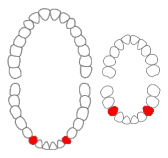Mandibular canine
Mandibular Canine[edit | edit source]
The mandibular canine is one of the canine teeth located in the mandible, or lower jaw, of the human dentition. It is also known as the lower canine or cuspid. The mandibular canine is a critical component of the dental arch and plays a significant role in the occlusion and aesthetics of the oral cavity.
Anatomy[edit | edit source]
The mandibular canine is characterized by its single, pointed cusp, which is used for tearing food. It is typically longer than the other teeth in the mandibular arch, with a prominent crown and a long root. The root of the mandibular canine is usually the longest in the mandibular arch, providing stability and support.
Crown[edit | edit source]
The crown of the mandibular canine is narrower than that of the maxillary canine, with a more pronounced cingulum on the lingual surface. The mesial and distal surfaces of the crown converge towards the incisal edge, giving the tooth a characteristic pointed appearance.
Root[edit | edit source]
The root of the mandibular canine is typically single and conical, with a slight distal inclination. It is often longer than the roots of the adjacent incisors and premolars, contributing to the tooth's anchorage in the jaw.
Function[edit | edit source]
Mandibular canines play a crucial role in the mastication process. Their pointed cusps are designed to pierce and tear food, complementing the grinding action of the molars. Additionally, they help maintain the vertical dimension of the face and contribute to the canine guidance in occlusion, which protects the posterior teeth during lateral excursions of the jaw.
Development[edit | edit source]
The mandibular canines typically erupt between the ages of 9 and 10 years. They are preceded by the primary canines, which are shed to make way for the permanent teeth. The development of the mandibular canines is a critical phase in the transition from primary to permanent dentition.
Clinical Significance[edit | edit source]
Mandibular canines are often involved in orthodontic treatments due to their strategic position in the dental arch. They may be subject to impaction or malposition, requiring intervention to ensure proper alignment and function. Additionally, the long roots of the mandibular canines make them ideal candidates for dental implants and prosthetic support in cases of tooth loss.
Related Pages[edit | edit source]
Search WikiMD
Ad.Tired of being Overweight? Try W8MD's physician weight loss program.
Semaglutide (Ozempic / Wegovy and Tirzepatide (Mounjaro / Zepbound) available.
Advertise on WikiMD
|
WikiMD's Wellness Encyclopedia |
| Let Food Be Thy Medicine Medicine Thy Food - Hippocrates |
Translate this page: - East Asian
中文,
日本,
한국어,
South Asian
हिन्दी,
தமிழ்,
తెలుగు,
Urdu,
ಕನ್ನಡ,
Southeast Asian
Indonesian,
Vietnamese,
Thai,
မြန်မာဘာသာ,
বাংলা
European
español,
Deutsch,
français,
Greek,
português do Brasil,
polski,
română,
русский,
Nederlands,
norsk,
svenska,
suomi,
Italian
Middle Eastern & African
عربى,
Turkish,
Persian,
Hebrew,
Afrikaans,
isiZulu,
Kiswahili,
Other
Bulgarian,
Hungarian,
Czech,
Swedish,
മലയാളം,
मराठी,
ਪੰਜਾਬੀ,
ગુજરાતી,
Portuguese,
Ukrainian
Medical Disclaimer: WikiMD is not a substitute for professional medical advice. The information on WikiMD is provided as an information resource only, may be incorrect, outdated or misleading, and is not to be used or relied on for any diagnostic or treatment purposes. Please consult your health care provider before making any healthcare decisions or for guidance about a specific medical condition. WikiMD expressly disclaims responsibility, and shall have no liability, for any damages, loss, injury, or liability whatsoever suffered as a result of your reliance on the information contained in this site. By visiting this site you agree to the foregoing terms and conditions, which may from time to time be changed or supplemented by WikiMD. If you do not agree to the foregoing terms and conditions, you should not enter or use this site. See full disclaimer.
Credits:Most images are courtesy of Wikimedia commons, and templates, categories Wikipedia, licensed under CC BY SA or similar.
Contributors: Prab R. Tumpati, MD

